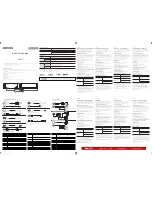
Revision 1.7.2
Page 23
depending on the vessel’s operating mode. Setting the vessel alert operating mode is described in
section 8.6.
The Operating Mode is one of:
Disabled
– All alerts are disabled. This mode should be used when the vessel is in storage,
dry-dock, or otherwise out of operation.
Moored
– This mode is used when the vessel is secured to a structure that is permanently
attached to the ground like a pier, wharf, dock, or mooring buoy.
Underway
– This mode is used when the vessel is not moored nor anchored.
Anchored
– This mode is used when the vessel is secured to the sea floor with an anchor.
NOTE
The DSM410 will always display global alerts generated by other devices on
the network, regardless of the Operating Mode selected.
4.3.5 Alert States
Alerts exist in one of five states.
Disabled
–
A Disabled Alert is an alarm or warning that has yet to be enabled or activated. In
this state, no action will be taken regardless of the value of the monitored parameter. A
Disabled Alert May be enabled in which case it transitions to the Inactive state
Inactive
–
An Inactive alert is an alarm or warning that has been enabled, but the condition
causing the alert is not present. If the alert condition becomes true, the alert will become an
Active Alert
. An Inactive alert may be disabled, which causes it to transition to the
Disabled
state. New alerts are created in the Inactive State.
Active
–
An Active alert is an alarm or warning where the condition to trigger the alert has been
met, and is still present and the operator has not accepted the alert. An active alert is indicated
by a flashing indicator on the Alert Status Screen, and by a flashing colored box at the top right
of the DSM410 screen. This box will be visible on all screens. Also, annunciators that are
programmed to sound when this alert is active will be sounding during this state. An active
alert can be accepted by the user (causing it to become an
Accepted Alert
) or disabled by the
user (causing it to become a
Disabled Alert
). If the condition causing the alert is rectified, the
alert transitions to the Awaiting Cancel state.
Accepted
– An Accepted alert is an alarm or warning which was Active and has been accepted
by the user. A solid indicator on the Alert Status Screen indicates an Accepted alert;
annunciators are silenced. Normally, an alert is a serious matter that requires immediate
attention and requires a deliberate attempt to remove the condition that caused the alert.
Sometimes it isn’t practical to immediately remove the condition that caused the alert;
accepting the alert will silence the annunciators while the appropriate user action is being
taken.
To prevent an alert that has accepted by the user from being forgotten, an accepted alert will
transition back to being Active after a period of time set by the user. If the condition causing
the alert is rectified (cleared), the alert will transition to the Inactive state.
You may disable the alert at this time, causing it to become a Disabled Alert.
Awaiting Cancel
– An Alert in the Awaiting Cancel state is an alert where the condition that
caused the alarm or warning has been removed without the alert being accepted while it was
















































